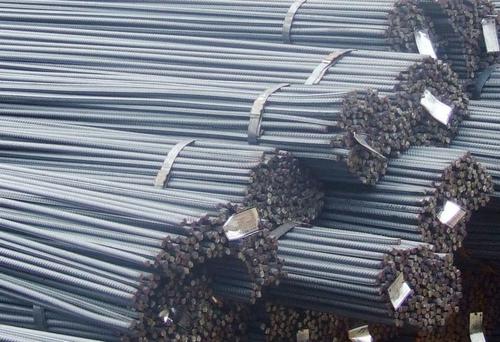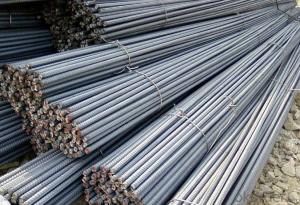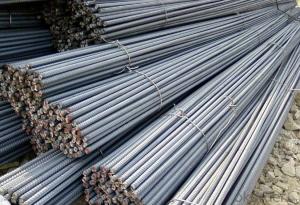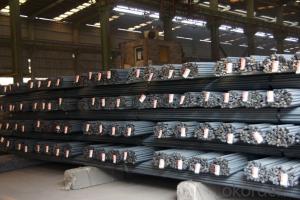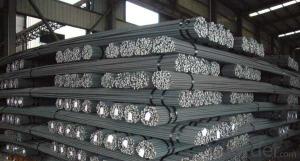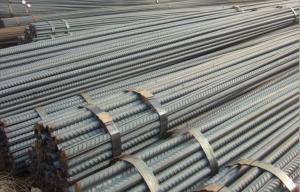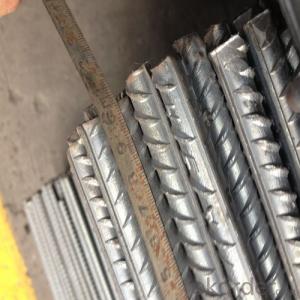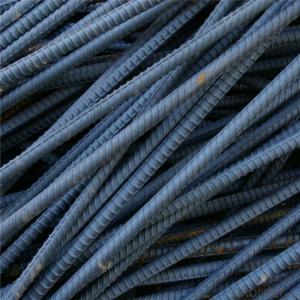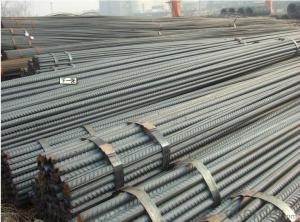Deformed Steel Bar ASTM A615 GR40 GR60 Or BS 4449
- Loading Port:
- China Main Port
- Payment Terms:
- TT or LC
- Min Order Qty:
- -
- Supply Capability:
- -
OKorder Service Pledge
OKorder Financial Service
You Might Also Like
Product Description:
OKorder is offering high quality Hot Rolled Steel I-Beams at great prices with worldwide shipping. Our supplier is a world-class manufacturer of steel, with our products utilized the world over. OKorder annually supplies products to European, North American and Asian markets. We provide quotations within 24 hours of receiving an inquiry and guarantee competitive prices.
Product Applications:
Deformed bar is widely used in buildings, bridges, roads and other engineering construction. Big to highways, railways, bridges, culverts, tunnels, public facilities such as flood control, dam, small to housing construction, beam, column, wall and the foundation of the plate, deformed bar is an integral structure material. With the development of world economy and the vigorous development of infrastructure construction, real estate, the demand for deformed bar will be larger and larger
Product Advantages:
OKorder's Steel I-Beams are durable, strong, and resist corrosion, exact size, regular package, chemical and mechanical properties are stable.
Main Product Features:
· Premium quality
· Prompt delivery & seaworthy packing (30 days after receiving deposit)
· Corrosion resistance
· Can be recycled and reused
· Mill test certification
· Professional Service
· Competitive pricing
Product Specifications:
Manufacture: Hot rolled
Grade: BS4449
Certificates: ISO, SGS, BV, CIQ
Diameter: 6mm,8mm,10mm,12mm,14mm,16mm,18mm,20mm,
22mm,25mm,28mm,32mm,36mm,40mm,50mm
Length: 6M, 9M,12M or as required
Packaging: Export packing, nude packing, bundled
Chemical Composition: (Please kindly find our chemistry of our material based on HRB500 as below for your information)
Grade | Technical data of the original chemical composition (%) | ||||||
C | Mn | Si | S | P | V | ||
HRB400 | ≤0.25 | ≤1.60 | ≤0.80 | ≤0.045 | ≤0.045 | 0.04-0.12 | |
Physical capability | |||||||
Yield Strength (N/cm²) | Tensile Strength (N/cm²) | Elongation (%) | |||||
≥400 | ≥570 | ≥14 | |||||
Theoretical weight and section area of each diameter as below for your information:
Diameter(mm) | Section area (mm²) | Mass(kg/m) | Weight of 12m bar(kg) |
6 | 28.27 | 0.222 | 2.664 |
8 | 50.27 | 0.395 | 4.74 |
10 | 78.54 | 0.617 | 7.404 |
12 | 113.1 | 0.888 | 10.656 |
14 | 153.9 | 1.21 | 14.52 |
16 | 201.1 | 1.58 | 18.96 |
18 | 254.5 | 2.00 | 24 |
20 | 314.2 | 2.47 | 29.64 |
22 | 380.1 | 2.98 | 35.76 |
25 | 490.9 | 3.85 | 46.2 |
28 | 615.8 | 4.83 | 57.96 |
32 | 804.2 | 6.31 | 75.72 |
36 | 1018 | 7.99 | 98.88 |
40 | 1257 | 9.87 | 118.44 |
50 | 1964 | 15.42 | 185.04 |
FAQ:
Q1: How soon can we receive the product after purchase?
A1: Within three days of placing an order, we will begin production. The specific shipping date is dependent upon international and government factors, but is typically 7 to 10 workdays.
Q2: What makes stainless steel stainless?
A2: Stainless steel must contain at least 10.5 % chromium. It is this element that reacts with the oxygen in the air to form a complex chrome-oxide surface layer that is invisible but strong enough to prevent further oxygen from "staining" (rusting) the surface. Higher levels of chromium and the addition of other alloying elements such as nickel and molybdenum enhance this surface layer and improve the corrosion resistance of the stainless material.
Q3: Can stainless steel rust?
A3: Stainless does not "rust" as you think of regular steel rusting with a red oxide on the surface that flakes off. If you see red rust it is probably due to some iron particles that have contaminated the surface of the stainless steel and it is these iron particles that are rusting. Look at the source of the rusting and see if you can remove it from the surface.

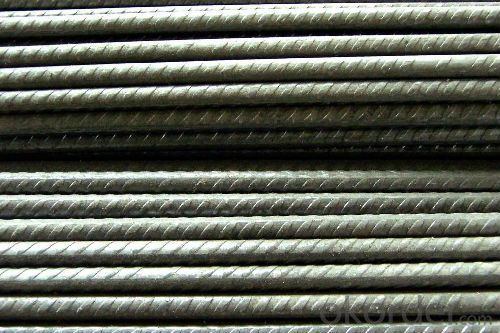
- Q: How do steel rebars affect the bond strength between concrete and reinforcement?
- Steel rebars have a significant positive impact on the bond strength between concrete and reinforcement. When embedded in concrete, rebars enhance the structural integrity by creating a mechanical bond. The rough texture of rebars provides a larger surface area for the concrete to adhere to, improving the bond strength. This bond is crucial in transferring forces between the two materials, ensuring the reinforced concrete can withstand loads and maintain its stability.
- Q: What are the precautions to be taken while welding steel rebars?
- When welding steel rebars, there are several precautions that need to be taken to ensure safe and effective welding: 1. Proper ventilation: Welding generates fumes and gases that can be harmful if inhaled. Therefore, it is important to work in a well-ventilated area or use exhaust systems to remove the fumes and maintain a safe breathing environment. 2. Personal protective equipment (PPE): Welders should always wear appropriate PPE, including a welding helmet or face shield, safety glasses, welding gloves, flame-resistant clothing, and steel-toed boots. This protective gear helps minimize the risk of burns, eye injuries, and other physical hazards. 3. Fire prevention: Welding involves intense heat and sparks, which can ignite flammable materials. Before starting the welding process, ensure that the work area is clear of any combustible materials, and have a fire extinguisher nearby. It is also advisable to have a fire watch person present to monitor the area for any potential fire hazards. 4. Grounding: Proper grounding is essential to prevent electrical shocks during welding. Ensure that the welding machine is properly grounded, and the workpiece is connected to a reliable grounding point. 5. Preparing the surface: Before welding, the surfaces of the rebars should be clean and free from any oils, grease, dirt, or rust. Use a wire brush or grinder to remove any contaminants, as they can affect the quality of the weld. 6. Welding technique: Employing the correct welding technique is crucial for achieving strong and reliable welds. Follow the recommended welding parameters, such as the appropriate current, voltage, and electrode diameter, to ensure optimal results. It is also important to maintain a steady hand and a consistent travel speed to prevent weld defects. 7. Training and experience: Welding steel rebars requires skill and knowledge. Ensure that the welder is properly trained and experienced in working with rebars. This will help minimize errors and ensure that the welds meet the required standards and specifications. By adhering to these precautions, welders can significantly reduce the risk of accidents, injuries, and subpar weld quality when working with steel rebars.
- Q: What are the different types of steel rebars used in building construction?
- The different types of steel rebars used in building construction include plain carbon steel rebars, epoxy-coated rebars, galvanized rebars, stainless steel rebars, and high-strength rebars.
- Q: Can steel rebars be used in the construction of airport runways and taxiways?
- Yes, steel rebars can be used in the construction of airport runways and taxiways.
- Q: How do steel rebars affect the durability of concrete?
- Steel rebars play a crucial role in enhancing the durability of concrete structures. They are typically embedded within the concrete to provide reinforcement and improve the overall strength and longevity of the structure. Firstly, steel rebars enhance the tensile strength of the concrete. While concrete has excellent compressive strength, it is weak in tension. When exposed to external forces or loads, concrete tends to crack and fail under tension. However, the inclusion of steel rebars helps to distribute the applied load throughout the structure, effectively resisting cracking and preventing the propagation of cracks. This reinforcement allows the concrete to withstand greater tensile forces, thus enhancing its durability. Additionally, steel rebars help to control the shrinkage and cracking of concrete. During the curing process, concrete undergoes shrinkage due to the evaporation of water. This shrinkage can lead to the formation of cracks, which can compromise the integrity of the structure. By incorporating steel rebars, the concrete is reinforced and the shrinkage is restrained, minimizing the occurrence and propagation of cracks. This, in turn, ensures the durability of the concrete by maintaining its structural integrity. Moreover, steel rebars are highly resistant to corrosion. Concrete is generally alkaline, which creates a protective layer on the surface of the steel rebars, preventing them from rusting or corroding. This resistance to corrosion is vital in maintaining the durability of concrete structures, especially in environments where they are exposed to moisture, chemicals, or other corrosive agents. The presence of steel rebars ensures that the concrete remains structurally sound and prevents any potential weakening or deterioration due to corrosion. In conclusion, steel rebars significantly enhance the durability of concrete structures. They improve the tensile strength, control shrinkage and cracking, and provide resistance to corrosion. By reinforcing the concrete, steel rebars ensure that the structure can withstand external forces, maintain its structural integrity, and have a longer lifespan.
- Q: Are there any specific guidelines for storing steel rebars on-site?
- Storing steel rebars on-site requires following specific guidelines. Consider the following key guidelines: 1. To prevent distortion or bending, rebars should be stored on a flat, level surface. If the ground is uneven, create a stable storage area using wooden pallets or metal racks. 2. The storage area must be clean and free from debris that could damage the rebars. Avoid storing rebars directly on the ground or in areas prone to water accumulation. 3. Proper stacking is crucial to prevent rebars from toppling over. Stack them in an organized manner, aligning them vertically and horizontally. Use spacers or separators to maintain adequate spacing between the rebars and prevent contact. 4. When storing rebars outdoors, protect them from rain, snow, and moisture by covering them with a waterproof tarp or plastic sheeting. This prevents rust and corrosion. 5. If rebars are stored indoors, ensure proper ventilation to prevent moisture buildup. This is especially important in humid environments to prevent rusting. 6. Keep rebars away from potential sources of damage, such as heavy machinery, construction equipment, or high-traffic areas. This reduces the risk of accidental damage during construction activities. 7. Regularly inspect the rebars for any signs of damage, rust, or corrosion. If any rebars are found to be damaged, remove them from storage and replace them to maintain structural integrity in the construction project. By adhering to these guidelines, steel rebars can be stored safely while maintaining their structural integrity for use in construction projects.
- Q: How are steel rebars used in tunnel construction?
- Steel rebars are used in tunnel construction to provide reinforcement and strength to the concrete structures. These rebars are embedded within the concrete walls, floors, and ceilings of the tunnel to enhance its structural integrity and prevent cracks or collapses.
- Q: What are the safety precautions when working with steel rebars?
- When working with steel rebars, it is important to follow several safety precautions to minimize the risk of accidents and injuries. Here are some key safety measures to consider: 1. Personal Protective Equipment (PPE): Always wear the appropriate PPE, including safety glasses or goggles, gloves, steel-toed boots, and a hard hat. This will protect you from potential hazards such as falling objects, flying debris, or accidental contact with sharp edges. 2. Training and awareness: Ensure that all workers involved in handling steel rebars receive proper training on safe work practices and are aware of the potential hazards associated with this work. Regular safety meetings and reminders can help reinforce this knowledge. 3. Proper lifting techniques: Steel rebars can be heavy and awkward to handle. Use proper lifting techniques, such as bending at the knees and lifting with your legs, to avoid strains or back injuries. If necessary, use mechanical lifting aids, such as cranes or hoists, to reduce the physical strain on workers. 4. Secure storage and handling: Store steel rebars in a secure and organized manner to prevent them from falling or rolling onto workers. When moving or transporting rebars, ensure they are properly secured to prevent them from shifting or falling during transit. 5. Cutting and bending precautions: When cutting or bending steel rebars, use appropriate tools and equipment, such as bolt cutters or rebar benders. Always wear protective gloves and ensure that the cutting or bending area is clear of other workers to prevent accidental injuries. 6. Fall protection: When working at heights, such as during the installation of rebars in elevated structures, ensure proper fall protection measures are in place. This may include using safety harnesses, guardrails, or safety nets to prevent falls. 7. Fire prevention: Steel rebars can generate sparks when cut or welded, so it is crucial to have proper fire prevention measures in place. Clear the work area of flammable materials, have fire extinguishers readily available, and follow appropriate welding safety protocols. 8. Regular equipment maintenance: Keep all tools and equipment used for handling steel rebars well-maintained and in good working condition. Regularly inspect them for any damage or defects that could compromise safety. By following these safety precautions, you can create a safer working environment when handling steel rebars and reduce the risk of accidents or injuries.
- Q: How do steel rebars affect the overall construction cost of residential buildings?
- Steel rebars can significantly impact the overall construction cost of residential buildings. While rebars add strength and durability to the structure, they also contribute to increased material and labor expenses. The cost of purchasing and installing rebars, along with associated construction techniques and reinforcing requirements, can raise the overall construction cost. However, considering the long-term benefits of reinforced structures, the investment in steel rebars is justified as it enhances the safety and longevity of residential buildings.
- Q: Are steel rebars resistant to chemical attacks?
- The resistance of steel rebars to chemical attacks may vary depending on the specific chemicals they encounter, although they are typically resistant. Steel rebars are primarily composed of carbon steel, renowned for its exceptional strength and durability. Carbon steel exhibits good resistance to numerous common chemicals, including water, mild acids, and alkalis. Nevertheless, certain chemicals can pose a threat to steel rebars by inducing corrosion or deterioration. For instance, powerful acids like sulfuric acid or hydrochloric acid can swiftly corrode steel rebars. Furthermore, exposure to chlorides, such as those present in saltwater or deicing salts, can heighten the risk of corrosion in steel rebars. To bolster the resistance of steel rebars against chemical attacks, several protective measures can be implemented. One prevalent approach involves the application of protective coatings, such as epoxy or zinc, onto the rebars. These coatings create a barrier between the steel and the chemicals, preventing direct contact and reducing the likelihood of corrosion. In conclusion, although steel rebars generally exhibit resistance to chemical attacks, their resistance can be influenced by the specific chemicals they encounter. By implementing appropriate protective measures, their resistance can be enhanced, thus prolonging their lifespan in environments where chemical exposure is a concern.
Send your message to us
Deformed Steel Bar ASTM A615 GR40 GR60 Or BS 4449
- Loading Port:
- China Main Port
- Payment Terms:
- TT or LC
- Min Order Qty:
- -
- Supply Capability:
- -
OKorder Service Pledge
OKorder Financial Service
Similar products
Hot products
Hot Searches
Related keywords



